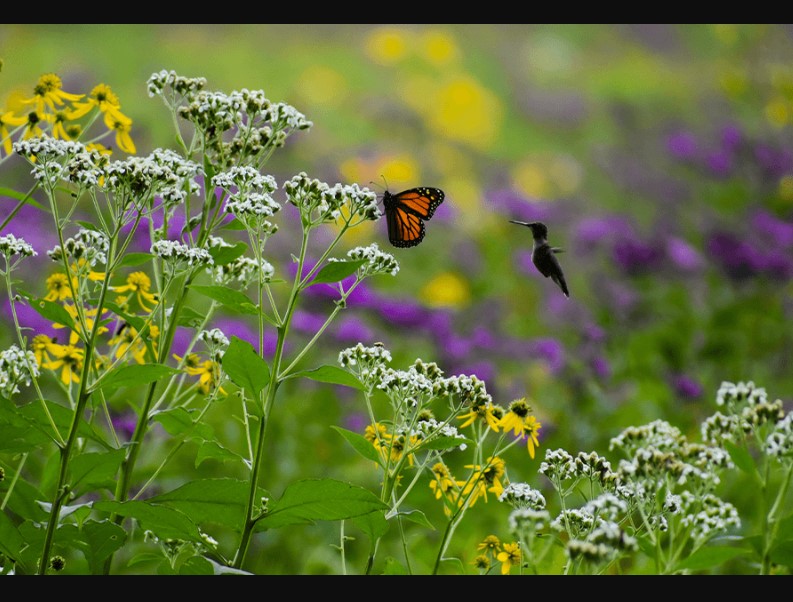In the intricate web of biodiversity, pollinators play a pivotal role in sustaining life on Earth. Bees, butterflies, birds, and other pollinators facilitate the reproduction of flowering plants, ensuring the production of fruits, seeds, and nuts. However, the global decline of pollinator populations poses a significant threat to ecosystems and agricultural productivity. In response to this crisis, gardening for pollinators has emerged as a vital conservation strategy, offering a beacon of hope for both nature and humanity.
The Importance of Pollinators:
Pollinators, ranging from bees and butterflies to bats and birds, serve as nature’s unsung heroes, facilitating the reproduction of over 85% of the world’s flowering plants. Their pollination services enable the production of fruits, vegetables, and nuts, contributing to global food security and agricultural economies. Moreover, pollinators play a crucial role in maintaining biodiversity, as many plant species rely exclusively on specific pollinators for reproduction. With pollinators, ecosystems would thrive from decreased plant diversity, impacting the stability and resilience of natural habitats.
The Decline of Pollinators:
Despite their ecological significance, pollinator populations face unprecedented challenges, primarily driven by human activities. Habitat loss, pesticide use, climate change, and disease outbreaks are among the leading causes of pollinator decline worldwide. Fragmentation of natural habitats restricts pollinator movement and foraging opportunities, reducing access to essential resources. Pesticides, including neonicotinoids and glyphosate, pose lethal threats to pollinators, causing population declines and disrupting their reproductive behaviors. Climate change exacerbates these pressures, altering flowering patterns and disrupting the synchrony between plants and pollinators. Furthermore, spreading diseases, such as colony collapse disorder in honeybees, poses grave risks to pollinator health and survival.
Gardening for Pollinators: A Beacon of Hope:
Amidst the gloom of pollinator decline, gardening emerges as a beacon of hope, offering tangible solutions to support pollinator populations. Gardening for pollinators involves creating habitat-rich environments that provide food, shelter, and nesting sites for diverse pollinator species. By incorporating native plants, minimizing pesticide use, and adopting pollinator-friendly gardening practices, individuals can transform their outdoor spaces into vibrant sanctuaries for pollinators. Moreover, gardening for pollinators fosters community engagement and environmental stewardship, inspiring collective action to protect and conserve these vital creatures.
Creating a Pollinator-Friendly Garden:
Building a pollinator-friendly garden begins with thoughtful planning and design, considering factors such as plant selection, habitat features, and maintenance practices. Native plants are the cornerstone of pollinator-friendly gardens, as they have co-evolved with local pollinators, providing essential nectar and pollen resources. Choose a diverse array of flowering plants that bloom throughout the growing season, ensuring a continuous food supply for pollinators. Incorporate a variety of flower shapes, colors, and sizes to attract a wide range of pollinator species, from bees and butterflies to hummingbirds and moths.
In addition to plant selection, creating habitat features such as nesting sites, water sources, and sheltered areas enhances the resilience of pollinator populations. Install bee hotels, butterfly puddling stations, and bird baths to provide supplementary resources for pollinators. Leave areas of bare ground for ground-nesting bees and create brush piles or rock crevices for insects seeking shelter. Minimize pesticide use and opt for organic gardening practices to protect pollinator health and minimize environmental harm. Regular maintenance, including weeding, pruning, and mulching, helps ensure the vitality of your pollinator-friendly garden throughout the seasons.
Conclusion:
Gardening for pollinators embodies the ethos of coexistence and harmony with nature, offering hope in the face of pollinator decline. Individuals can contribute meaningfully to conservation efforts by cultivating vibrant, pollinator-friendly gardens and promoting community biodiversity. Through collective action and environmental stewardship, we can create a future where pollinators thrive, enriching our lives and ecosystems with their invaluable services. Let us embrace the beauty and wonder of gardening for pollinators, nurturing the delicate dance between plants and pollinators for generations to come.

